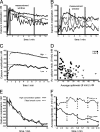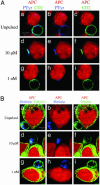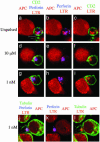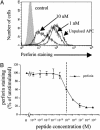Lytic versus stimulatory synapse in cytotoxic T lymphocyte/target cell interaction: manifestation of a dual activation threshold
- PMID: 14610278
- PMCID: PMC283560
- DOI: 10.1073/pnas.2334336100
Lytic versus stimulatory synapse in cytotoxic T lymphocyte/target cell interaction: manifestation of a dual activation threshold
Abstract
Activation of biological functions in T lymphocytes is determined by the molecular dynamics occurring at the T cell/opposing cell interface. In the present study, a central question of cytotoxic T lymphocyte (CTL) biology was studied at the single-cell level: can two distinct activation thresholds for cytotoxicity and cytokine production be explained by intercellular molecular dynamics between CTLs and targets? In this study, we combine morphological approaches with numerical analysis, which allows us to associate specific patterns of calcium mobilization with different biological responses. We show that CTLs selectively activated to cytotoxicity lack a mature immunological synapse while exhibiting a low threshold polarized secretion of lytic granules and spike-like patterns of calcium mobilization. This finding is contrasted by fully activated CTLs, which exhibit a mature immunological synapse and smooth and sustained calcium mobilization. Our results indicate that intercellular molecular dynamics and signaling characteristics allow the definition of two activation thresholds in individual CTLs: one for polarized granule secretion (lytic synapse formation) and the other for cytokine production (stimulatory synapse formation).
Figures





Comment in
-
Function-specific variations in the immunological synapses formed by cytotoxic T cells.Proc Natl Acad Sci U S A. 2003 Nov 25;100(24):13739-40. doi: 10.1073/pnas.2536626100. Epub 2003 Nov 17. Proc Natl Acad Sci U S A. 2003. PMID: 14623966 Free PMC article. No abstract available.
Similar articles
-
Peptide modification or blocking of CD8, resulting in weak TCR signaling, can activate CTL for Fas- but not perforin-dependent cytotoxicity or cytokine production.J Immunol. 1998 Dec 15;161(12):6939-46. J Immunol. 1998. PMID: 9862728
-
Centrosome polarization delivers secretory granules to the immunological synapse.Nature. 2006 Sep 28;443(7110):462-5. doi: 10.1038/nature05071. Nature. 2006. PMID: 17006514
-
Expression and function of synaptotagmin VII in CTLs.J Immunol. 2007 Feb 1;178(3):1498-504. doi: 10.4049/jimmunol.178.3.1498. J Immunol. 2007. PMID: 17237398 Free PMC article.
-
The binding and lysis of target cells by cytotoxic lymphocytes: molecular and cellular aspects.Annu Rev Immunol. 1994;12:735-73. doi: 10.1146/annurev.iy.12.040194.003511. Annu Rev Immunol. 1994. PMID: 8011296 Review.
-
The secretory synapse: the secrets of a serial killer.Immunol Rev. 2002 Nov;189:152-60. doi: 10.1034/j.1600-065x.2002.18913.x. Immunol Rev. 2002. PMID: 12445272 Review.
Cited by
-
Scrutinizing calcium flux oscillations in T lymphocytes to deduce the strength of stimulus.Sci Rep. 2015 Jan 14;5:7760. doi: 10.1038/srep07760. Sci Rep. 2015. PMID: 25585590 Free PMC article.
-
Bacterial lipopolysaccharide inhibits influenza virus infection of human macrophages and the consequent induction of CD8+ T cell immunity.J Innate Immun. 2014;6(2):129-39. doi: 10.1159/000353905. Epub 2013 Aug 20. J Innate Immun. 2014. PMID: 23970306 Free PMC article.
-
Immunological synapse arrays: patterned protein surfaces that modulate immunological synapse structure formation in T cells.Proc Natl Acad Sci U S A. 2006 Apr 11;103(15):5700-5. doi: 10.1073/pnas.0509404103. Epub 2006 Apr 3. Proc Natl Acad Sci U S A. 2006. PMID: 16585528 Free PMC article.
-
T-cell antagonism by short half-life pMHC ligands can be mediated by an efficient trapping of T-cell polarization toward the APC.Proc Natl Acad Sci U S A. 2010 Jan 5;107(1):210-5. doi: 10.1073/pnas.0911258107. Epub 2009 Dec 14. Proc Natl Acad Sci U S A. 2010. PMID: 20075022 Free PMC article.
-
A scDb-based trivalent bispecific antibody for T-cell-mediated killing of HER3-expressing cancer cells.Sci Rep. 2021 Jul 6;11(1):13880. doi: 10.1038/s41598-021-93351-0. Sci Rep. 2021. PMID: 34230555 Free PMC article.
References
-
- Kagi, D., Vignaux, F., Ledermann, B., Burki, K., Depraetere, V., Nagata, S., Hengartner, H. & Golstein, P. (1994) Science 265, 528–530. - PubMed
-
- Lowin, B., Hahne, M., Mattmann, C. & Tschopp, J. (1994) Nature 370, 650–652. - PubMed
-
- Sykulev, Y., Joo, M., Vturina, I., Tsomides, T. J. & Eisen, H. N. (1996) Immunity 4, 565–571. - PubMed
-
- Sanderson, C. J. (1976) Proc. R. Soc. London Ser. B 192, 241–255. - PubMed
-
- Isaaz, S., Baetz, K., Olsen, K., Podack, E. & Griffiths, G. M. (1995) Eur. J. Immunol. 25, 1071–1079. - PubMed
Publication types
MeSH terms
Substances
LinkOut - more resources
Full Text Sources
Other Literature Sources

